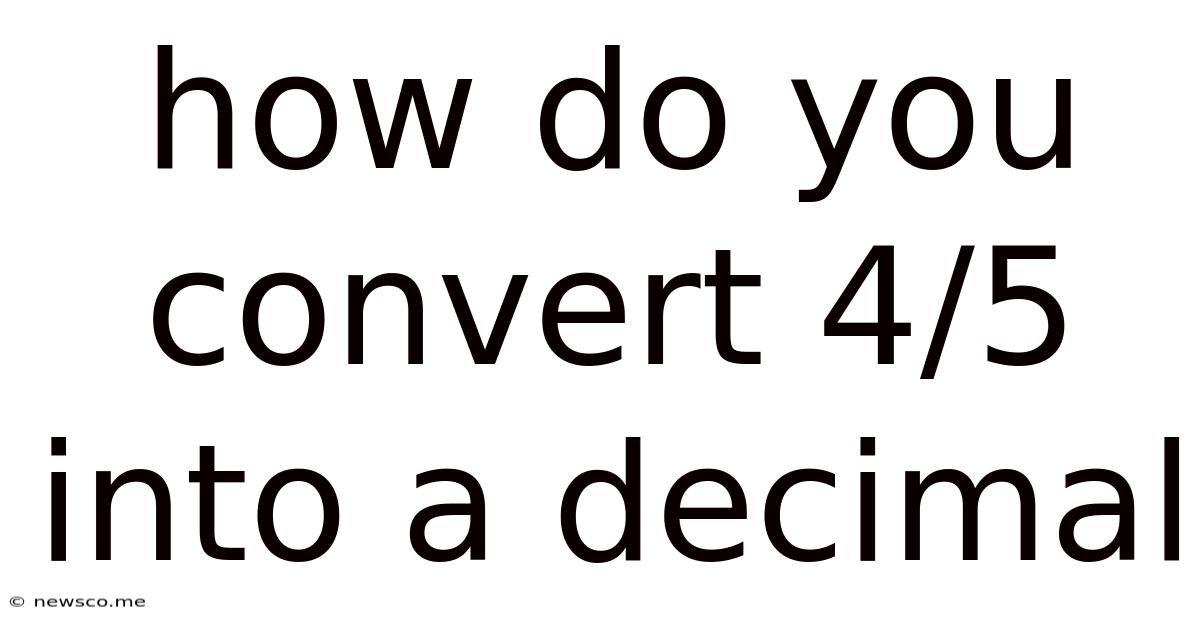How Do You Convert 4/5 Into A Decimal
News Co
Apr 02, 2025 · 5 min read

Table of Contents
How Do You Convert 4/5 Into a Decimal? A Comprehensive Guide
Converting fractions to decimals is a fundamental skill in mathematics with wide-ranging applications in various fields. This comprehensive guide will walk you through the process of converting the fraction 4/5 into a decimal, explaining the underlying principles and offering various methods to achieve this conversion. We'll also explore the broader context of fraction-to-decimal conversions, providing you with the tools to tackle similar problems with confidence.
Understanding Fractions and Decimals
Before diving into the conversion, let's refresh our understanding of fractions and decimals.
Fractions represent parts of a whole. They consist of a numerator (the top number) and a denominator (the bottom number). The numerator indicates how many parts you have, while the denominator indicates how many parts make up the whole.
Decimals are another way to represent parts of a whole. They use a base-ten system, where each digit to the right of the decimal point represents a power of ten (tenths, hundredths, thousandths, and so on).
Method 1: Direct Division
The most straightforward method for converting a fraction to a decimal is through direct division. In this method, we divide the numerator by the denominator.
Step-by-Step for 4/5:
-
Identify the numerator and denominator: In the fraction 4/5, the numerator is 4 and the denominator is 5.
-
Perform the division: Divide the numerator (4) by the denominator (5): 4 ÷ 5 = 0.8
Therefore, 4/5 as a decimal is 0.8.
Method 2: Equivalent Fractions with a Denominator of 10, 100, 1000, etc.
Another effective method involves converting the fraction into an equivalent fraction with a denominator that is a power of 10 (10, 100, 1000, etc.). This allows for a direct conversion to a decimal.
Step-by-Step for 4/5:
-
Find an equivalent fraction: We need to find a number that, when multiplied by 5, results in a power of 10. In this case, multiplying the denominator (5) by 2 gives us 10.
-
Maintain equivalence: To maintain the equivalence of the fraction, we must multiply both the numerator and the denominator by the same number (2). This gives us: (4 x 2) / (5 x 2) = 8/10
-
Convert to a decimal: A fraction with a denominator of 10 can be easily converted to a decimal. The numerator (8) becomes the digit to the right of the decimal point, giving us 0.8.
Method 3: Using a Calculator
For more complex fractions, a calculator provides a convenient and efficient way to convert fractions to decimals. Simply enter the numerator, then the division symbol (/), and finally the denominator. The calculator will automatically perform the division and display the decimal equivalent.
For 4/5, entering 4 / 5 into a calculator will directly yield 0.8.
Understanding Decimal Place Value
The decimal representation of 4/5, 0.8, signifies eight-tenths. The digit 8 is in the tenths place, meaning it represents 8/10. Understanding decimal place value is crucial for interpreting and working with decimals effectively.
Applications of Fraction-to-Decimal Conversions
The ability to convert fractions to decimals is vital in various areas:
-
Finance: Calculating percentages, interest rates, and financial ratios often involve converting fractions to decimals.
-
Science: Many scientific calculations and measurements utilize decimals, requiring the conversion of fractions.
-
Engineering: Precision engineering relies on decimal measurements for accuracy and efficiency.
-
Everyday Life: Dividing items equally, calculating discounts, and understanding proportions all necessitate converting fractions to decimals.
Converting Other Fractions to Decimals
The methods described above can be applied to convert other fractions to decimals. However, some fractions may result in repeating or non-terminating decimals.
Example: Converting 1/3 to a decimal
-
Direct Division: 1 ÷ 3 = 0.33333... (a repeating decimal)
-
Equivalent Fraction: There is no power of 10 that is a multiple of 3.
This illustrates that not all fractions convert to terminating decimals. Repeating decimals are represented using a bar over the repeating digits (e.g., 0.3̅).
Advanced Concepts: Terminating vs. Repeating Decimals
Fractions can result in two types of decimals:
-
Terminating Decimals: These decimals have a finite number of digits after the decimal point (e.g., 0.8, 0.25, 0.125). These typically result from fractions whose denominators have only 2 and/or 5 as prime factors.
-
Repeating Decimals: These decimals have an infinite number of digits that repeat in a pattern (e.g., 0.3̅, 0.6̅6̅, 0.142857̅). These often occur when the denominator has prime factors other than 2 and 5.
Practical Tips and Troubleshooting
-
Simplify the fraction: Before converting, always simplify the fraction to its lowest terms. This simplifies the division process.
-
Check your work: Use a calculator to verify your results, especially when dealing with more complex fractions.
-
Understand repeating decimals: Learn to recognize and represent repeating decimals using the appropriate notation.
Conclusion: Mastering Fraction-to-Decimal Conversions
Converting fractions to decimals is a crucial mathematical skill with far-reaching applications. By understanding the fundamental principles and applying the various methods outlined in this guide, you can confidently convert fractions to decimals, regardless of their complexity. Remember to practice regularly to solidify your understanding and improve your speed and accuracy. This will undoubtedly enhance your problem-solving abilities in various mathematical and real-world contexts. Through consistent practice and a solid grasp of the underlying concepts, you'll become proficient in this essential skill.
Latest Posts
Related Post
Thank you for visiting our website which covers about How Do You Convert 4/5 Into A Decimal . We hope the information provided has been useful to you. Feel free to contact us if you have any questions or need further assistance. See you next time and don't miss to bookmark.